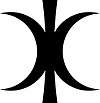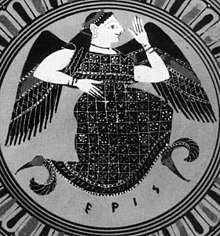Discordianism
Discordianism is a paradigm based upon the book Principia Discordia,[1] written by Greg Hill with Kerry Wendell Thornley in 1963, the two working under the pseudonyms Malaclypse the Younger and Omar Khayyam Ravenhurst. According to self-proclaimed "crackpot historian" Adam Gorightly, Discordianism was founded as a parody religion. Many outside observers still regard Discordianism as a parody religion, although some of its adherents may utilize it as a legitimate religion or as a metaphor for a governing philosophy.[2]
The Principia Discordia, if read literally, encourages the worship of the Greek goddess Eris, known in Latin as Discordia, the goddess of disorder, or archetypes and ideals associated with her. Depending on the version of Discordianism, Eris might be considered the goddess exclusively of disorder or the goddess of disorder and chaos. Both views are supported by the Principia Discordia. The Principia Discordia holds three core principles: the Aneristic (order), the Eristic (disorder), and the notion that both are mere illusions. Due to these principles, a Discordian believes there is no distinction between order and disorder, since they are both man-made conceptual divisions of the pure element of chaos. An argument presented by the text is that it is only by rejecting these principles that you can truly perceive reality as it is, chaos.
It is difficult to estimate the number of Discordians because they are not required to hold Discordianism as their only belief system,[3] and because, by nature of the system itself, there is an encouragement to form schisms and cabals.[4][5]
Founding and structure
The foundational document of Discordianism is the Principia Discordia, fourth edition, written by Malaclypse the Younger, an alias of Greg Hill. The Principia Discordia often hints that Discordianism was founded as a dialectic antithesis to more popular religions based on order, although the rhetoric throughout the book describes chaos as a much more underlying impulse of the universe. This may have been done with the intention of merely "balancing out" the creative forces of order and disorder, but the focus is on the more disorderly aspects of the world – at times the forces of order are even vilified.[6][7]
Popes
According to the Principia Discordia, "every single man, woman, and child on this Earth" is deemed a pope.[8]
Included in the Principia Discordia is an official pope card that may be reproduced and distributed freely to anyone and everyone.[8] Papacy, however, is not granted through possession of this card; it merely informs people that they are "a genuine and authorized Pope" of Discordia.
Saints
There are also five classes of saints within Discordianism, who are those who best act as exemplars and are closer to perfection.[9] Only the first of these classes "Saint Second Class" contains real human beings (deceased and alive), with higher classes reserved for fictional beings who, by virtue of being fictional, are better able to reach the Discordian view of perfection.[10]
A well-known example of a second-class saint is Emperor Norton, a citizen in 19th century San Francisco, who despite suffering delusions was beloved by much of the city. He is honoured as a saint within Discordianism for living his life according to truth as he saw it and a disregard for reality as others would perceive it.[11]
Mythology
Eris and Aneris
In discordian mythology, Aneris is described as the sister of Eris a.k.a. Discordia. Whereas Eris/Discordia is the goddess of disorder and being, Aneris/Harmonia is the goddess of order and non-being.
"DOGMA III – HISTORY 32, 'COSMOGONY' " in Principia Discordia, states:
- In the beginning there was VOID, who had two daughters; one (the smaller) was that of BEING, named ERIS, and one (the larger) was of NON-BEING, named ANERIS.[12]
The sterile Aneris becomes jealous of Eris (who was born pregnant), and starts making existent things non-existent. This explains why life begins, and later ends in death.
- And to this day, things appear and disappear in this very manner.[12]
The names of Eris and Aneris (who are later given a brother, Spirituality), are used to show some fundamental Discordian principles in "Psycho-Metaphysics":
- The Aneristic Principle is that of APPARENT ORDER; the Eristic Principle is that of APPARENT DISORDER. Both order and disorder are man made concepts and are artificial divisions of PURE CHAOS, which is a level deeper than is the level of distinction making.[13]
Hand of Eris

The hand of Eris (shown at right) and other proposed symbols are used informally in certain circles; however, it is unlikely that Eris, the trans-Neptunian dwarf planet, will be assigned an official symbol by the IAU, since graphical symbols are rarely assigned to minor objects in modern times.[14][15] A request to the Unicode Consortium to add the hand as a unicode symbol to represent the planet, along with a symbol for 90377 Sedna, was filed in 2016[16] and accepted the same year, releasing with Unicode 11 as ERIS FORM ONE.[17]
The "original snub"
The "original snub" is the Discordian name for the events preceding the judgement of Paris, although more focus is put on the actions of Eris. Zeus believes that Eris is a troublemaker, so he does not invite her to Peleus and Thetis's wedding. Having been snubbed, Eris creates a golden apple with the word kallisti (Ancient Greek: καλλίστη, to the prettiest one) inscribed in it. This, the Apple of Discord, is a notable symbol in Discordianism for its inclusion in the Holy Chao, and is traditionally described as being made of gold (although whether that gold was metallic or Acapulco is noted as uncertain[18]).[19]
Some recent interpretations of the original snub place Eris as being not at all mischievous with her delivery of the apple, but instead suggest that Eris was simply bringing the apple as a wedding present for Thetis. This interpretation would see Eris as innocent and her causing of chaos as a by-product of the other wedding guests' reaction upon seeing her at the wedding.[20][21]
Philosophy
Three core principles
The Principia Discordia holds three core principles: the Aneristic and Eristic principles representing order and disorder, and the notion that both are mere illusions. The following excerpt summarizes these principles:
The Aneristic Principle is that of apparent order; the Eristic Principle is that of apparent disorder. Both order and disorder are man made concepts and are artificial divisions of pure chaos, which is a level deeper than is the level of distinction making.
With our concept-making apparatus called "the brain" we look at reality through the ideas-about-reality which our cultures give us. The ideas-about-reality are mistakenly labeled "reality" and unenlightened people are forever perplexed by the fact that other people, especially other cultures, see "reality" differently.
It is only the ideas-about-reality which differ. Real (capital-T) True reality is a level deeper than is the level of concept. We look at the world through windows on which have been drawn grids (concepts). Different philosophies use different grids. A culture is a group of people with rather similar grids. Through a window we view chaos, and relate it to the points on our grid, and thereby understand it. The order is in the grid. That is the Aneristic Principle.
Western philosophy is traditionally concerned with contrasting one grid with another grid, and amending grids in hopes of finding a perfect one that will account for all reality and will, hence, (say unenlightened westerners) be true. This is illusory; it is what we Erisians call the Aneristic Illusion. Some grids can be more useful than others, some more beautiful than others, some more pleasant than others, etc., but none can be more True than any other.
Disorder is simply unrelated information viewed through some particular grid. But, like "relation", no-relation is a concept. Male, like female, is an idea about sex. To say that male-ness is "absence of female-ness", or vice versa, is a matter of definition and metaphysically arbitrary. The artificial concept of no-relation is the Eristic Principle.
The belief that "order is true" and disorder is false or somehow wrong, is the Aneristic Illusion. To say the same of disorder, is the Eristic Illusion.
The point is that (little-t) truth is a matter of definition relative to the grid one is using at the moment, and that (capital-T) Truth, metaphysical reality, is irrelevant to grids entirely. Pick a grid, and through it some chaos appears ordered and some appears disordered. Pick another grid, and the same chaos will appear differently ordered and disordered.[22]
Operation Mindfuck
Operation Mindfuck is an important practice in the Discordian religion. The concept was developed by Kerry Thornley and Robert Anton Wilson in 1968[23] and given its name by Wilson and Robert Shea in The Illuminatus! Trilogy.[24]
Writings
Discordian works include a number of books, not all of which actually exist. Among those that have been published are Principia Discordia, first published in 1965 (which includes portions of The Honest Book of Truth); and The Illuminatus! Trilogy, which had its first volume published in 1975.[25]
The Principia Discordia is a Discordian religious text written by Greg Hill (Malaclypse the Younger) with Kerry Wendell Thornley (Lord Omar Khayyam Ravenhurst).The phrase Principia Discordia, reminiscent of Newton's Principia Mathematica, is presumably intended to mean Discordant Principles, or Principles of Discordance.[26]
Summa Universalia was another work by Malaclypse the Younger, purported to be a summary of the universe. It was excerpted in the first edition of Principia but never published. It was mentioned in an introduction to one of the Principia editions, and the work was quoted from in the first edition.[27][28]
Zenarchy was first self-published by Thornley, under the pen name Ho Chi Zen, as a series of one-page (or broadsheet) newsletters in the 1960s.[29] A selection of the material was later reedited and expanded by Thornley and republished in paperback by IllumiNet Press in 1991. The book describes Thornley's concept of Zenarchy "a way of Zen applied to social life. A non-combative, non-participatory, no-politics approach to anarchy intended to get the serious student thinking."[30]
One of the most influential of all Discordian works, the Illuminatus! Trilogy is a series of three novels written by Robert Shea and Robert Anton Wilson purportedly between 1969 and 1971.[31] In a 1980 interview given to the science fiction magazine Starship, Wilson suggested the novel was an attempt to build a myth around Discordianism.
We felt the Discordian Society needed some opposition, because the whole idea of it is based on conflict and dialectics. So, we created an opposition within the Discordian Society, which we called the Bavarian Illuminati [...] So, we built up this myth about the warfare between the Discordian Society and the Illuminati for quite a while, until one day Bob Shea said to me, "You know, we could write a novel about this!"[32]
Zen Without Zen Masters is a book by Camden Benares (The Count of Five), published in 1977, of koans, stories and exercises of a Discordian nature. It includes tales of several early Discordians including Hill (as Mal) and Thornley (as Omar and Ho Chi Zen). "Enlightenment of a Seeker" from this book is also present in Principia Discordia as "A Zen Story".[33]
Principia Discordia editions
The first edition was printed using Jim Garrison's Xerox printer in 1963.[34] The second edition was published under the title Principia Discordia or How The West Was Lost in a limited edition of five copies (and released into the public domain) in 1965.[35]


 NARA Cover sheet for the alleged First Edition
NARA Cover sheet for the alleged First Edition
In 1978, a copy of a work from Kerry Thornley titled THE PRINCIPIA Discordia or HOW THE WEST WAS LOST was placed in the HSCA JFK collections as document 010857.[36] Adam Gorightly, author of The Prankster and the Conspiracy about Kerry Thornley and the early Discordians, said the copy in the JFK collection was not a copy of the first edition but a later and altered version containing some of the original material. In an interview with researcher Brenton Clutterbuck,[37] Gorightly said he had been given Greg Hill's copy of the first edition. This appeared in its entirety in Historia Discordia, a book on Discordian history released in spring of 2014.[38][39]
Several other editions have been published by Steve Jackson Games, Ronin Publishing, and others.
Related works
The Black Iron Prison
The Black Iron Prison was an effort by the Good Reverend Roger — among other authors — to create an updated, modern book that would function as Principia Discordia did when released. The collaborators stated that "while the original Principia Discordia holds important messages and philosophies, we wondered if some of the humor and language might be dated and lost on a younger generation of Discordians. We wanted to crystalize some of our favorite themes from the Principia, those of radical free will and self-emancipation." The goal was to encourage "critical thinking and self awareness" in the reader.[40]
Ek-sen-trik-kuh Discordia: The Tales of Shamlicht
Ek-sen-trik-kuh Discordia: The Tales of Shamlicht by Reverend Loveshade with "foreplay" or foreword by S. John Ross was published in 2012 by Anaphora Literary Press.[41] The controversial book reportedly was inspired by an investigation by the FBI with portions of the book having been previously seized. Ek-sen-trik-kuh Discordia includes blurbs (short reviews of the book) by R. Crumb, Sondra London, Alan Moore, Rev. Ivan Stang, Robert Anton Wilson (who saw an early draft), and others.[42][43] It was listed in January 2013 in both the print and online version of the New York Review of Books.[43] The book was soon pulled from publication after allegations of plagiarism were made on amazon.com and sent to the publisher. An editor denied the claims which did not specify what material was allegedly plagiarized.[41][44] The publisher stated, "In part, I took the book out of print because I was receiving harassing phone calls and emails with threat of harm via 'discordian' jakes, and my phone was infected with a virus with a Discordian flavor."[45]
Historia Discordia
Historia Discordia was compiled by Adam Gorightly with foreword by Robert Anton Wilson.[46] It is a compilation of early Discordian photos, tracts, art collages, and more including works by Discordianism founders Greg Hill (Malaclypse the Younger) and Kerry Thornley (Omar Khayyam Ravenhurst).[47] Among other things, it contains the long-missing The Honest Book of Truth and the first edition of Principia Discordia.[48] It features a blurb by famed comic book writer Alan Moore.[47]
See also
References
- Wilson, Robert Anton (1992). Cosmic Trigger I: Final Secret of the Illuminati. Scottsdale, AZ: New Falcon Publications. p. 65. ISBN 978-1561840038.
- "...It should on no account be taken seriously but is far more serious than most jokes" and "See ... [also] ha ha only serious" (The Jargon File v4.4.7) but present at least as far back as v4.0.0, (1996, July 24). An entry for discordianism begins, "Somewhere between parody, social commentary, and religion..." (Rabinovitch, Shelly & Lewis, James R. The Encyclopedia of Modern Witchcraft and Neo-Paganism, pp. 75–76. Citadel Press. 2002. ISBN 0-8065-2406-5). "These organisations [Discordianism & The Church of the SubGenius] are just two of a whole raft of mock religions..." (Phillips, M. (2004, Sept. 14)). "Wizards of ID cook up divine pile of spaghetti bolognese" The West Australian, p. 18. "The explosion of the American counter-culture and the revival of surrealism met Discordianism (1960s and 1970s) and the result was a Neo-Pagan parody religion of mirth and laughter." p. 3 of Eris Kallisti Discordia. (2005). The Book of Eris.
- Rabinovitch, Shelly & Lewis, James. The Encyclopedia of Modern Witchcraft and Neo-Paganism". pp. 75–76. Citadel Press. 2002. ISBN 0-8065-2406-5.
- "WitchVox Traditions Discordianism Article". Witchvox.com. Archived from the original on 30 September 2007. Retrieved 2009-08-31.
- "Discordian Cabals – S23Wiki". S23.org. Retrieved 2013-03-26.
- "World Religions". Worldreligions.psu.edu. Archived from the original on 2009-06-24. Retrieved 2009-08-31.
- "Design Arguments for the Existence of God [Internet Encyclopedia of Philosophy]". Iep.utm.edu. 2009-04-12. Retrieved 2009-08-31.
- Malaclypse the Younger, Principia Discordia, Page 00036
- Younger, Malaclypse The (11 January 2010). "Principia Discordia". Lulu.com – via Google Books.
- Malaclypse the Younger, Principia Discordia, Page 00039
- Cusack, Carole M. (6 May 2016). "Invented Religions: Imagination, Fiction and Faith". Routledge – via Google Books.
- "Page 56". Principia Discordia. Retrieved 2012-08-19.
- See (a certain chapter [about "SOME PSYCHO-METAPHYSICS"] of Principia Discordia) For an online version, see: From: some user ("bloodstar84") of Geocities (2009-10-27). "HERE FOLLOWS SOME PSYCHO-METAPHYSICS / *** Principia Discordia ***". Geocities. Archived from the original on October 27, 2009. Retrieved 2012-08-19. (Note: Geocities is now defunct, but "see also" Reocities, which is a static snapshot, that does not require you to have an "archiveurl" from the Wayback machine.)
- Keiron Le Grice: Discovering Eris: The Symbolism and Significance of a New Planetary Archetype. Edinburgh 2012, ISBN 978-0863158674
- Moskowitz, Denis (July 3, 2013). "Symbols for large trans-Neptunian objects". suberic.net. Central Nacional de Astrologia. Retrieved December 18, 2019.
- Faulks, David (June 12, 2016). "Eris and Sedna Symbols" (PDF). unicode.org. Archived from the original (PDF) on May 8, 2017.
- "Proposed New Characters: Pipeline Table". unicode.org. 27 January 2017. Archived from the original on 31 March 2017. Retrieved 20 May 2020.
- Principia Discordia. p. 00018. ISBN 9781387762668.
- "JUDGEMENT OF PARIS - Greek Mythology". www.theoi.com.
- Scullion, Sean (Nov 26, 2007). Liber Malorum - Children of the Apple. PagAnarchy Press. p. 375. ISBN 978-0955798405.
- Swiss, Tom (2009). Tom Swiss: Eris and the so-called "Apple of Discord".
- Malaclypse the Younger. Principia Discordia. p. 49-50.
- Gorightly, Adam (2005). "The Prankster or The Manchurian Candidate?". The Beast of Adam Gorightly: Collected Rantings (1992-2004). Virtualbookworm Publishing. p. 163. ISBN 978-1-58939-781-1. Retrieved 2008-12-02.
- Shea, Robert; Robert Anton Wilson (1976). Illuminatus!. Sphere Books. ISBN 978-0-7221-9208-5. Retrieved 2008-12-02.
- Cosmic Trigger I: The Final Secret of the Illuminati (1977), page 167. ISBN 1-56184-003-3
- In Latin, discordia is not an adjective. It can be a singular noun by itself, meaning "discord", or, like principia, be the plural of a noun – discordium, also meaning "discord". In either case, the phrase consists of two juxtaposed nouns without a grammatical relationship.
- "By no means is the Principia our only scripture. All along Greg has been writing what he says is a summary of the Universe, but evidently it will be quite some time before he completes it." Thornley, Kerry: "Principia Discordia", page ix. Illuminet Press, 1991. As quoted at https://www.cs.cmu.edu/~tilt/principia/intro5.html.
- Malaclypse and Ravenhurst: Principia Discordia, pages 2, 10, A14."Excerpted from a treatise concerning The Nature of Gods and The Eristesque Movement, to be found in the SUMMA UNIVERSALIA, the Holy Work of MALACLYPSE (THE YOUNGER), K.C., Omniscient Polyfather of Virginity-in-gold, and High Priest of The Heretic Fringe and Protestant Persuasion of the ERISIAN MOVEMENT of the DISCORDIAN SOCIETY " As found at http://appendix.23ae.com/pd1/17.html, http://appendix.23ae.com/pd1/25.html , http://appendix.23ae.com/pd1/14.html .
- Groover, Joel (1998-12-03). "Kerry Thornley, philosopher, writer, friend of Oswald" (fee required). Atlanta Journal-Constitution. p. F8. Retrieved 2008-03-24.
- Kerry Thornley, "Zenarchy" (1991), ISBN 0962653411
- Illuminatus! was written between 1969 and 1971, but not published until 1975 according to Robert Anton Wilson, Cosmic Trigger I: The Final Secret of the Illuminati (1977), page 145. ISBN 1-56184-003-3
- "Robert Anton Wilson: Searching For Cosmic Intelligence" by Jeffrey Elliot Archived 2006-06-14 at the Wayback Machine Interview discussing novel . Retrieved 21 February 2006.
- Camden Benares: Zen Without Zen Masters (1977), pages 40-41. ISBN 978-1-56184-073-1
- Wilson, Robert Anton (1992). Cosmic Trigger I: Final Secret of the Illuminati. Scottsdale, AZ: New Falcon Publications. p. 65. ISBN 978-1561840038.
- Frauenfelder, Mark (November 1, 2006). "Publisher alters, then copyrights Principia Discordia". Boing Boing.
- The record identifier can be found by searching for Thornley and Discordian on nara.gov Archived 2008-09-17 at the Wayback Machine. "Kennedy Assassination Collection: Discordian Socity [sic]". National Archives and Records Administration. Archived from the original on 5 November 2012. Retrieved 17 February 2012.
- "Wikinews interviews Brenton Clutterbuck". Wikinews. Retrieved 29 August 2013.
- "Adam Gorightly presents the COMPLETE first edition Principia Discordia". Retrieved 29 August 2013.
- Adam Gorightly: "Historia Discordia" (2014). ISBN 1618613219
- "The Black Iron Prison". blackironprison.com.
- "Anaphora Literary Press: Reverend Loveshade". Anaphora Literary Press. 2012. Retrieved 2013-01-24.
- Loveshade, Reverend (2012). Ek-sen-trik-kuh Discordia: The Tales of Shamlicht. Anaphora Literary Press. ISBN 978-1937536183.
- "Independent Press Listing" (PDF). New York Review of Books. 2013-01-10. Archived from the original (PDF) on 2013-01-24. Retrieved 2013-01-24.
- "Ek-sen-trik-kuh Discordia". amazon.com. Retrieved 2013-10-26.
- "Anaphora Literary Press". Absolute Write. Retrieved 2013-10-26.
- "Historia Discordia". RVP Press. 2014. Retrieved 2016-07-26.
- "Historia Discordia". RVP Press. 2014. Retrieved 2016-07-26.
- Griffin, Andrew W. (August 6, 2014). "BOOK REVIEW: "Historia Discordia" by Adam Gorightly". Red Dirt Report. Retrieved 2016-07-26.
External links
- Erischan.org – A discordian imageboard.
- PrincipiaDiscordia.com – contains the Principia Discordia in HTML. Also has Discordian message boards and other resources.
- The Semi-Official Quasi-Clandestine Bavarian Illuminati/Discordian Archives An archive of early Discordian documents, photos and paraphernalia.
- Discordian Saints – 1999 archive from Andrew C. Bulhak.
- Discordian Tarot with 'Reading' – the free deck consists of 73 cards, incl. 23 Trumps (also as PDF, 0.7 MB)

